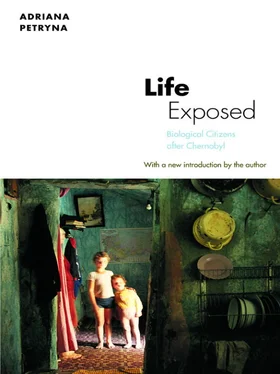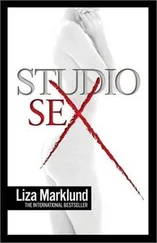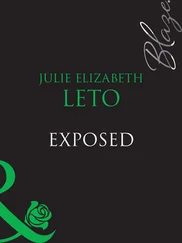Chesser and Baker 2006:546. Their 1996 study published in Nature found that voles living in the Chernobyl zone had a higher rate of genetic mutation. Upon resequencing genes using an automated gene sequencer, they found they could not replicate the initial result.
See Baker and Wickliffe (2011) on the Chernobyl “wildlife” thesis and compare with the findings of Mousseau and Møller (2011).
Cited from interview with Keith Baverstock, longtime head of the Department for Radiation and Health of WHO, http://www.ippnw-students.org/chernobyl/baverstock.html.
See Gale and Baranov 2011:17.
Meyer 2011. The 18,000 figure is as of October 31, 2011. See Wada et al. 2012. For critical insights on the fate of the Fukushima workers, see Jobin 2012.
John Boice, quoted in Bradsher and Tabuchi 2011.
The maximum estimated exposure per worker was 670.4 mSv. See Wada et al. 2012:599. mSv is a unit of ionizing radiation absorbed dose.
See Brumfiel 2012.
See Sheila Jasanoff’s illuminating essay (Jasanoff 2003).
Lubchenco 2012.
On tipping points, see Guterl 2012. On high-consequence outcomes and internal disagreements about their presentation, see Socolow 2011.
“The purpose of the experiment was to test the possibility of using the mechanical energy of the rotor in a turbo-generator cut off from steam supply to sustain the amounts of power requirements during a power failure” (IAEA, Soviet State Committee on the Utilization of Atomic Energy 1986:16).
See Sich 1996. With these and all other compounding factors, “estimates of the long-term health consequences of the Chernobyl accident are uncertain even as to the order of magnitude” (Von Hippel 1991:235).
By May 2, 1986, short reports were published in local newspapers.
Thirteen thousand children in affected regions absorbed a radiation dose to the thyroid of more than twice the maximum allowable dose for nuclear workers for an entire year. See Shcherbak 1996.
Iodine pills raise the amounts of iodide in the bloodstream so that the thyroid cannot absorb more. The radioactive iodine to which a person is exposed is excreted in the urine.
Estimates vary from 600,000 to 800,000. These workers were recruited from all over the Soviet Union. But the labor pool drew most heavily from Ukrainian and Russian populations.
The karbovanets (Krb) was Ukraine’s legal tender from 1992 to 1996. Exchange rates per $1.00 US plunged between 1992 and 1993. In March 1992, the exchange rate was 640 Krb:$l. By March 1993, that rate had lowered to 12,610 Krb:$l. Subsequent rates were as follows: 1994—104,200:$ 1; 1995—179,900:$1; 1996—188,700:$1. The hryvna (HRN) replaced the karbovanets at HRN1:Krbl00,000 in September of 1996. The exchange rates were as follows: 1997—1.84:$1; 1998-2.04:$1; 1999—4.13:$1; 2000—5.44:$1.
Such values are calculated on the basis of “rem-expenditures” workers accrue; their amounts are limited by international standards. Despite the existence of such standards, norms of worker exposures are being decided locally and within the constraints of local economies that “undervalue” workers’ lives by exposing them to more risk for less pay.
Social suffering “results from what political, economic, and institutional power does to people, and, reciprocally, from how these forms of power themselves influence responses to social problems” (Kleinman, Das, and Lock 1996:i).
The Soviet period refers to the years 1986-1991. The post-Soviet period refers to 1991 and beyond.
Differences between sufferers and the disabled will be addressed in chapter 4.
Personal communication, Ministry of Emergencies (Chernobyl Section, Division of International Relations). In Russia, the number of people considered affected and compensatable has been kept to a minimum and remains fairly stable (about 350,000, including 300,000 Zone laborers and 50,000 persons now resettled in noncontaminated areas).
In fact, the Belarussian government has encouraged its own people, as well as Russians living outside the new borders of Russia (mainly in Central Asia and the Caucasus, where war is ongoing), to take up residence in contaminated areas, offering them housing, jobs, and resident status. See Ackerman 2000.
As of 1999, 50 percent of the population lives below the poverty line. The inflation rate is at 20 percent. The gross domestic product (GDP) has fallen by 60 percent since independence. This figure, however, overstates the fall in output, since the informal economy has been expanding (Country Brief, World Bank, 1999).
Yet even this view is contradicted within Belarus. The director of the Research and Clinical Institute of Radiation Medicine and Endocrinology in Minsk indicated that “perhaps the biggest surprise in the first few years after the explosion was that a spate of leukemia cases, predicted from Japanese atom bomb survivor studies, never materialized.” See Stone 2001.
Here I draw on insights from Shapin and Schaffer 1985:15, “Solutions to the problem of knowledge are embedded within practical solutions to the problem of social order, and… different practical solutions to the problem of social order encapsulate contrasting solutions to the problem of knowledge.”
As Frank Von Hippel (2000) notes, the main battleground for the debate over whether there is a threshold dose below which radiation is not harmful is the regulation of nuclear power.
For Foucault, the nuclear era represented biopower’s culmination. “If nuclear energy is the modern capacity to expose populations to unprecedented kinds of risk and potential death, it is also the underside of the power to generate life through the biological administration of individuals and populations (1980a:137).
The United States Department of Energy initiated the Human Genome Project the same year that Chernobyl happened. See, for example, Cook-Deegan 1994.
“In the future, the new genetics will cease to be a biological metaphor for modern society and will become instead a circulation network of identity terms and restriction loci, around which and through which a truly new type of autoproduction will emerge, which I call ‘biosociality’ ” (Rabinow 1996a:99).
Veena Das has illustrated the ways pain and suffering are rationalized within state mechanisms and affected societies. In the case of India’s Bhopal chemical disaster, state health professionals and bureaucrats de-authenticated the suffering of victims by insisting that objective measures replace self-reports of victims as means of assessing the consequences of chemical exposure. Something similar happened in the Soviet administration of the Chernobyl disaster. As an effect, pain and suffering “may also be experiences which are actively created and distributed by the social order itself” (1995:138). See “Suffering, Legitimacy, and Healing: The Bhopal Case,” in Das 1995.
Читать дальше












